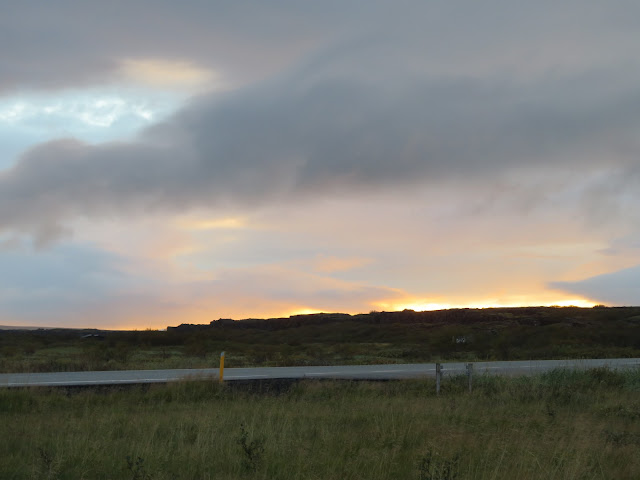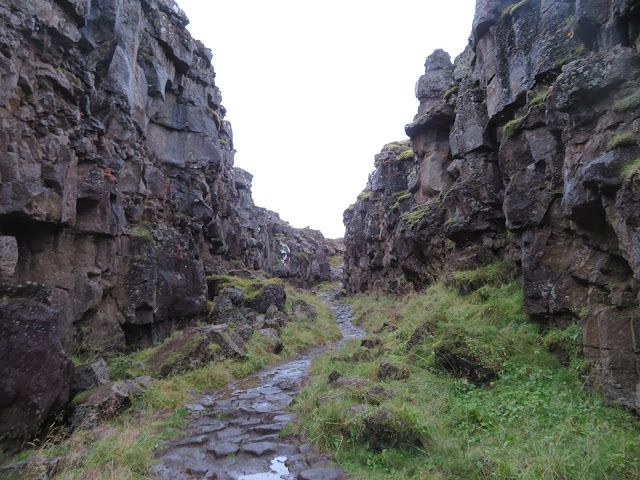For Friday, October 1 and Saturday, October 2
My last morning with the campervan. I got myself all cleaned up at the campground. Showered and in fresh clothes. Then I got everything all packed up. All of the dishes I had used that morning got washed. Then the problem was it was only 9. I had figured out bus schedules so that I could board the bus toward Keflavik Airport at 12:53. I didn’t have to turn in the van until noon. I dillydallied around for a bit and then got gas, but that still didn’t take very long. I ended up finding a parking lot and reading for 45 minutes before finally going to turn in the van. That was pretty easy overall. After that, I had a 20 minute walk to where the airport bus picks up from. There were sidewalks the whole way, which was great. I still was really early though. I walked along the shore a little bit, and then found a place to settle down by a little pond. An hour or so later the bus arrived and I took my last bus ride through Iceland.
 |
| Hafnarfjordur |
After I got off the bus I had a 10 minute walk to Hotel Berg, where I was spending the night. I decided I was going to stay at a nice hotel for that last night in Iceland. In fact, after totally up the cost of all the campsites I stayed at, I discovered that one night at the hotel was equal to about 12 nights camping (for one). I also finally took a look at the math and looked at how far I drove during my 2 weeks with the van. 3,291 km. 2044 miles. The Ring Road is actually only 828 miles long. But I did a lot of side offshoots, plus there were two places where I literally doubled-back on roads; one of those on purpose (the day I went to see the volcano) and the other not (the day the road was closed and I thought I was going to die). But the whole point of the trip was to see Iceland, so I wouldn’t take back any of those miles.
But I digress. Friday afternoon after checking into Hotel Berg, I went for a walk along the retaining wall in Keflavik. Right below the cliff my hotel was on was the home of a giant. A beloved Icelandic children’s book series involves a giantess and a young girl. They had built the giantess’ home under the cliff and when you walk in there you can actually hear the breathing of the giantess, and she is sitting by the window looking out, probably 15 feet tall (while sitting).
 |
| The Giantess's Home from across the harbor at Keflavik. |
From there, I continued the walk along the wall. There was one place where there were two large rocks that looked like people (art, not by chance) and a viewing platform of the rock retaining wall. There was a cute little story on a sign about how back in 2005, shortly after the wall had been built to keep the ocean from eroding the shoreline, the kindergarteners wrote to the mayor to request some stairs so they could see the water over the rocks. They built the platform so the kids could see. It was a lessen in civics for the kids and it was cute to see that they had followed through.
 |
| The viewing platform at Keflavik. |
I followed the path for probably over a mile and saw a lot of bird, some art, and an old lighthouse (which I discovered that night, is still actually used). After walking back to the hotel to debate what to do for supper for an hour until it was a more respectable hour for food, I went through all the financials for the trip. Besides the van and airfare, the greatest portion of the trip’s cost came on fuel, which ran me about $375. An hour or so later I went to eat at a restaurant near my hotel. It was the first sit-down restaurant I had eaten at the whole trip. When I had gotten food it had thrice come in the form of a croissant (chocolate or ham/cheese) and once in the form of a hot dog (they’re big into hot dogs in Iceland), so I can’t really tell you how much eating out every day would have cost, but it probably would have beeen A LOT more that the $90ish I spent on groceries.
After supper I changed into my swimsuit and spent two hours soaking and sitting on the edge of the pool (all pools in iceland are hot tubs, just minus the jets). I watched and the sun went down and hoped to see the Nothern Lights pop out. After I headed in, I got everything ready so all I’d have to do in the morning was shower, get dressed, and put what I had worn to bed in my bag. Then I headed back outside with a blanket for about 30 minutes in my last quest to see the Northern Lights. Unfortunately they did not come out for me to see during the time I was sitting outside, meaning I left Iceland without ever having seen them, so that was disappointing. Someday I’ll get to see them. Maybe on another trip to Iceland in the future (because there were some things I missed out on due to weather), or on a trip to Scandanavia.
Sunset from the pool at Hotel Berg
In the morning, everything went as planned and I was to the airport with plenty of time to spare. A 6 ½ hour flight to Minneapolis-St. Paul, followed by a 2 hour layover, and an hour and a half flight home to Wichita. It’s been a fun trip for sure. But I’ll definitely be happy to be back in my own bed. And I want a chicken sandwich so badly. Haha!
 |
| Goodbye Iceland! |







